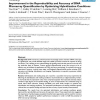Free Online Productivity Tools
i2Speak
i2Symbol
i2OCR
iTex2Img
iWeb2Print
iWeb2Shot
i2Type
iPdf2Split
iPdf2Merge
i2Bopomofo
i2Arabic
i2Style
i2Image
i2PDF
iLatex2Rtf
Sci2ools
BMCBI
2006
2006
Improvement in the Reproducibility and Accuracy of DNA Microarray Quantification by Optimizing Hybridization Conditions
Background: DNA microarrays, which have been increasingly used to monitor mRNA transcripts at a global level, can provide detailed insight into cellular processes involved in response to drugs and toxins. This is leading to new understandings of signaling networks that operate in the cell, and the molecular basis of diseases. Custom printed oligonucleotide arrays have proven to be an effective way to facilitate the applications of DNA microarray technology. A successful microarray experiment, however, involves many steps: well-designed oligonucleotide probes, printing, RNA extraction and labeling, hybridization, and imaging. Optimization is essential to generate reliable microarray data. Results: Hybridization and washing steps are crucial for a successful microarray experiment. By following the hybridization and washing conditions recommended by an oligonucleotide provider, it was found that the expression ratios were compressed greater than expected and data analysis revealed a high...
Related Content
| Added | 10 Dec 2010 |
| Updated | 10 Dec 2010 |
| Type | Journal |
| Year | 2006 |
| Where | BMCBI |
| Authors | Tao Han, Cathy D. Melvin, Leming M. Shi, William S. Branham, Carrie L. Moland, P. Scott Pine, Karol L. Thompson, James C. Fuscoe |
Comments (0)

